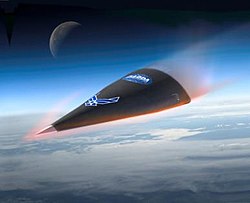From Wikipedia, the free encyclopedia
Hypersonic Technology Vehicle 2 (HTV-2) is a crewless,[1] experimental rocket glider developed as part of the DARPA Falcon Project capable of flying at 13,000 mph (21,000 km/h).[2] It is testing technologies to provide the United States with the capability to strike any target in the world within one hour.[3]Development
The Falcon HTV-1 program, which preceded the Falcon HTV-2 program, was conducted in April, 2010. The mission ended within nine minutes from launch.[3] Both these missions are funded by the US Defense Advanced Research Projects Agency (DARPA) to help develop hypersonic technologies and to demonstrate its effectiveness.[4]Design
Development of protection structures that are tough and light-weight, development of an aerodynamic shape that has a high lift to drag ratio, development of automatic navigation control systems etc. were some of the initial technical challenges that had been overcome in the final design.[4] The various departments involved in designing the vehicle included aerothermodynamics, materials science, hypersonic navigation, guidance and control systems, endo- and exo-atmospheric flight dynamics, telemetry and range safety analysis. The Sydney Morning Herald notes that when flying its fastest, the craft could cover 17,000 kilometres, the distance between London and Sydney, in 49 minutes.[3]Flight testing
The HTV-2's first flight was launched on 22 April 2010.[5] The HTV-2 glider was to fly 4,800 miles (7,700 km) across the Pacific to Kwajalein at Mach 20.[6] The HTV-2 was boosted by a Minotaur IV Lite rocket launched from Vandenberg Air Force Base, California. The flight plan called for the craft to separate from the launch vehicle, level out, and glide above the Pacific at Mach 20.[1][3] Contact had been lost with the vehicle nine minutes into the 30-minute mission.[3][7][8] In mid-November DARPA stated that the first test flight had ended when the computer autopilot had "commanded flight termination" after it had begun to roll violently.[9]A second flight was initially scheduled to be launched on August 10, 2011, but bad weather forced a delay.[10] The flight was launched the following day, on 11 August 2011. The unmanned Falcon HTV-2 successfully separated from the booster and entered the mission's glide phase, but again lost contact with control about nine minutes into its planned 30-minute Mach 20 glide flight. Initial reports indicated it purposely impacted the Pacific Ocean along its planned flight path as a safety precaution.[11][12][13]




No comments:
Post a Comment